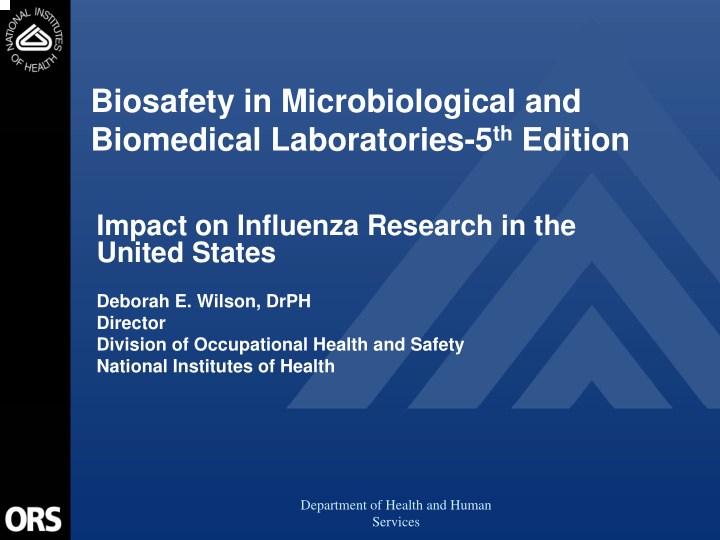



Biosafety in Microbiological and Biomedical Laboratories-5 th Edition Impact on Influenza Research in the United States Deborah E. Wilson, DrPH Director Division of Occupational Health and Safety National Institutes of Health Department of Health and Human Services
The BMBL Revision Process • Government Steering Committee • Centers for Disease Control and Prevention • National Institutes of Health • Guest Editors • Working Groups • Reviewers Department of Health and Human Services
BMBL Revision Process • Update and Revise 4 th Edition • Not a major re-write • General appearance and format will be retained • Agent Summary Statements are being updated and revised Department of Health and Human Services
BMBL Revision Process • Agent Summary Statements are added when: • Evidence of laboratory-acquired infection • Significant public health impact or interest Department of Health and Human Services
BMBL Revision Process • Several New Chapters • Occupational Health and Medicine • General Concepts of Biosecurity • Biosafety Level 3(Ag) • Emphasis added on Risk Assessment • Additional Appendices Department of Health and Human Services
BMBL Revision Process • Complex process • Involves many people • Guest Editors 30 • Contributors 70 • Animal Biosafety Levels Workgroup 25 • Biosafety Levels Workgroup 25 • Biosafety Level 3 (Ag) 25 • Does not include reviewers Department of Health and Human Services
BMBL Revision Process Expected Release Date Department of Health and Human Summer 2005 Services
Impact on Influenza Research ? • Agent Summary Statement is being revised • Control of Influenza is a continuing human and veterinary public health concern • Department of Health and Human Services and Department of Agriculture are working closely to harmonize requirements for the conduct of scientific research Department of Health and Human Services
Factors of Interest to the Influenza Workgroup • Pathogenicity of the viruses • Route of transmission • Agent stability (environmental) • Infectious dose • Virulence data from animal studies • Availability of effective prophylaxis or therapeutic intervention Department of Health and Human Services
Factors of Interest to Influenza Workgroup • Experience and skill of at-risk personnel • Source of the virus (geographic) • Potential risk to laboratory worker • Pandemic potential • Agricultural/economic risk Department of Health and Human Services
Risk Assessment Factors Applied to: • Contemporary, circulating human influenza strains (e.g., H1/H3/B) • Low pathogenicity avian influenza (LPAI) strains (e.g., H1-4, H6, H8-15) • Non-contemporary human influenza (e.g., H2N2) • Highly pathogenic avian influenza (HPAI) • Research involving reverse genetics of the 1918 influenza strain Department of Health and Human Services
Recombinants vs. Reassortants • The BMBL will bridge the gap left by the NIH Guidelines for Research Involving Recombinant DNA Molecules regarding experiments creating or using influenza reassortants. Department of Health and Human Services
Other Influenza reassortants or recombinants • The gene constellation used • Clear evidence of reduced virus replication in the respiratory tract of appropriate animal models compared with the replication of wild-type parent virus from which it was derived • Evidence of clonal purity and phenotypic stability • The number of years since a virus that was antigenically related to the donor of the hemagglutinin and neuraminidase genes last circulated Department of Health and Human Services
Occupational Health Considerations • Personnel counseling and monitoring • Availability of antiviral drugs for treatment and post-exposure prophylaxis • Baseline serum storage • Respiratory protection program Department of Health and Human Services
Recommend
More recommend